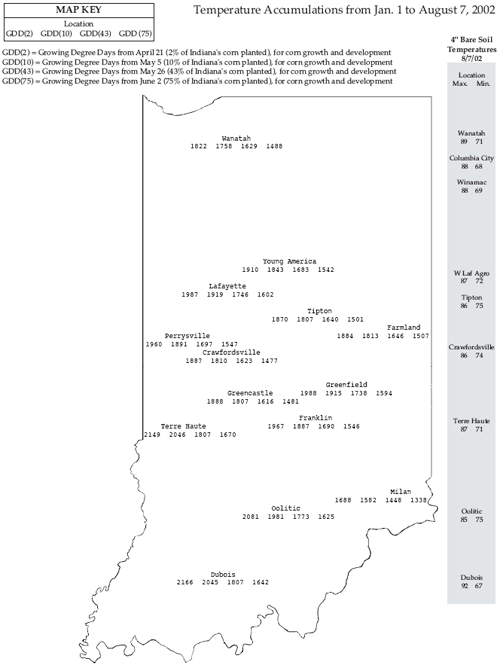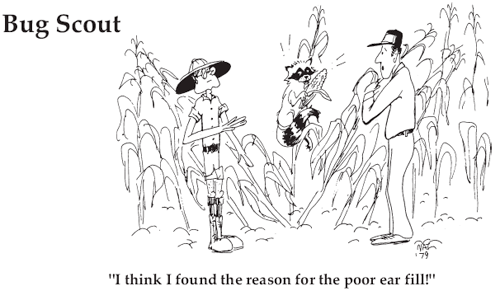Pest & Crop Newsletter
|
||||||||
Spider Mite Damage Appearing in Some Soybean Fields- (John Obermeyer, Rich Edwards, and Larry Bledsoe)
Spider mite activity is obvious in some stressed soybean fields. Spider mites are migrating from field edges, as they dry, into the soybeans. While soybeans are under moisture stress their plant juices actually becomes a “protein broth” that benefits spider mites growth and development. Populations can explode in just days! Along field edges of moisture stressed fields look for discolored, yellowing and bronzing, soybeans. Shake discolored plants over a white piece of paper and watch for small dark specks (1/60 inch in length) moving about. Once spider mites have been positively identified in the damaged area(s) of the field, it is essential that the whole field be scouted to determine the range of the infestation. Sample at least 5 different areas of the field and determine whether the spider mites are present or not by using the “shake” method. Spot treatments may be effective if infestations are caught early enough and the mites have not yet moved across the field. Success of spot treatments depends on spraying beyond the infested area, not just the damaged area. Spray a buffer zone of at least 200 feet beyond spider mite colonized plants. If scouting results indicate that movement has occurred within several areas of a field or throughout a field, then treating the whole field should be considered. Residual activity of insecticides (dimethoate or Lorsban) will last at most 10-14 days, new soybean growth will not be protected. We recommend nozzle pressures of 40 psi and no less that 20 gallons of water per acre for ground equipment. Normally aerial applications are not as efficacious, treatments with less that 3 gallons of finished spray per acre should not be attempted.
|
||||||||
Yield Loss During Grain Fill– (Bob Nielsen) Yield potential in corn is influenced at several stages of growth and development. Ear size potential (number of potential kernels) is determined quite early, from about knee-high to about shoulder-high, or from about leaf stage V6 to V15. The next influential period for the corn crop is pollination. The period following successful pollination and finishing at kernel black layer is defined as the grain filling period in corn and represents the final important yield determining time frame. Grain fill stages in corn were described in a recent article (Grain Fill Stages in Corn, P&C Newsletter, 8/2/02). Perfect conditions for ear size determination and pollinations can still be negated if severe stress occurs during the grain fill period.
Yield loss during grain fill can occur from 1) stand loss, 2) incomplete kernel set, 3) lightweight kernels, and 4) premature plant death. Stand Loss During Grain Fill Incomplete Kernel Set in Corn One of the causes of incomplete kernel set is unsuccessful pollination. Unsuccessful pollination results in ovules that are never fertilized and, subsequently, ears with varying degrees and patterns of incomplete kernel set. Many factors can cause incomplete pollination and distinguishing between them can be very difficult. Certain insects like corn rootworm beetles and Japanese beetles can interfere with pollination and fertilization by their silk clipping action. These insects feed on pollen and subsequently clip silks as they feed on the pollen that has been captured by the silks. Unusually early or late pollinating fields are often particularly attractive to these insects. Drought stress may delay silk emergence until pollen shed is nearly or completely finished. During periods of high temperatures, low relative humidities, and inadequate soil moisture levels, exposed silks may also dessicate and become non-receptive to pollen germination. Unusually favorable conditions prior to pollination that favor ear size determination can result in ears with an unusually high number of potential kernels per row. Remember that silk elongation begins near the butt of the ear and progresses up toward the tip. The tip silks are typically the last to emerge from the husk leaves. If ears are unusually long (many kernels per row), the final silks from the tip of the ear may emerge after all the pollen has been shed. Another cause of incomplete kernel set is abortion of fertilized ovules. Aborted kernels are distinguished from unfertilized ovules in that aborted kernels had actually begun development. Aborted kernels will be shrunken, mostly white, often with the yellow embryo visible; compared to normal plump yellow kernels. Kernels are most susceptible to abortion during the first 2 weeks following pollination, particularly kernels near the tip of the ear. Tip kernels are generally last to be fertilized, less vigorous than the rest, and are most susceptible to abortion. Once kernels have reached the dough stage of development, further yield losses will occur mainly from reductions in kernel dry weight accumulation. Severe drought stress that continues into the early stages of kernel development (blister and milk stages) can easily abort developing kernels. Severe nutrient deficiencies (especially nitrogen) can also abort kernels if enough of the photosynthetic ‘factory’ is damaged. Extensive loss of green leaf tissue by certain leaf diseases, such as common rust or gray leaf spot, by the time pollination occurs may limit photosynthate production enough to cause kernel abortion. Consecutive days of heavily overcast, cloudy conditions may also reduce photosynthesis enough to cause abortion in recently fertilized ovules. Decreased Kernel Weight Once grain has reached physiological maturity, stress will have no further physiological effect on final yield, because final yield is already achieved. Stalk and ear rots, however, can continue to develop after corn has reached physiological maturity and indirectly reduce grain yield. Premature Plant Death Premature death of whole plants results in greater yield losses than if only leaves are killed. Death of all plant tissue prevents any further remobilization of stored carbohydrates to the developing ear. Whole plant death that occurs before normal black layer formation will cause premature black layer development, resulting in incomplete grain fill and lightweight, chaffy grain. Grain moisture will be greater than 35%, requiring substantial field drydown before harvest. Don’t forget, this and other timely information about corn can be viewed at the Chat ‘n Chew Café on the World Wide Web at <http://www.kingcorn.org/cafe>. For other information about corn, take a look at the Corn Growers’ Guidebook on the World Wide Web at <http://www.kingcorn.org/ >.
|
||||||||

|
















